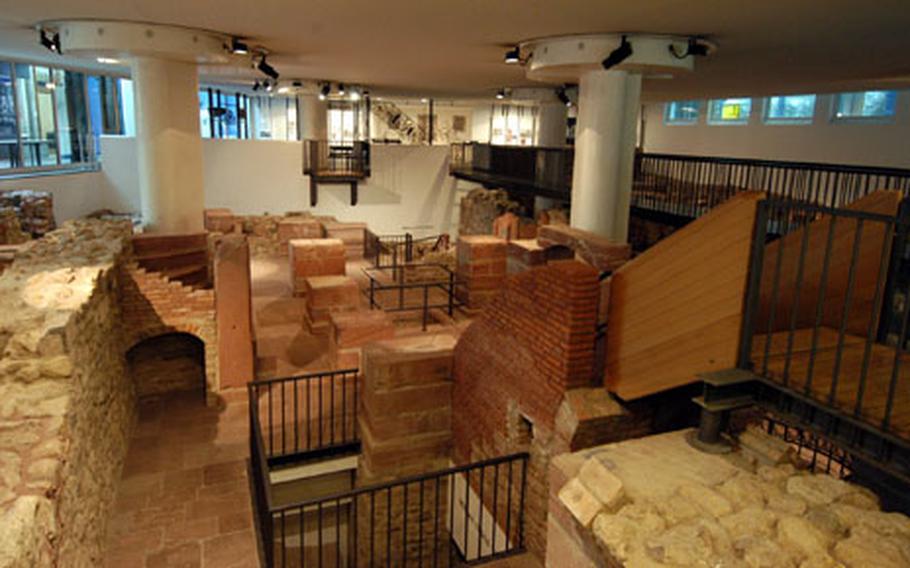
The foundations of houses of the Judengasse, including two "mikvehs," or ritual baths, can be seen at the Museum Judengasse. It is incorporated into the customer service center of Stadtwerke, Frankfurt's municipal utilities company. The foundations were found during construction of the building in 1987. (Michael Abrams / S&S)
Before the Holocaust, Frankfurt had the second largest Jewish community in Germany, after Berlin. For more than 800 years, Jews were a part of the city life, until those dark days of the 20th century when they were deported and murdered by the Nazis.
Today, there is again a thriving Jewish community in Frankfurt, and its history, from the early Middle Ages to the present, can be traced at the Jewish Museum and its annex, the Museum Judengasse, in downtown Frankfurt.
The Jewish Museum, opened in 1988, is housed in the 19th century Rothschild Palais and the building next to it, on the banks of the Main River. Spread over two floors, it is broken down into three major sections: Jews in Frankfurt from 1100 to 1800, from 1800 to 1950, and a religious and cultural exhibit titled “Jewish Life — Jewish Rituals.” The ground floor has rooms for temporary exhibits (from now until April 18, a Marc Chagall exhibit) and a cafe/bookstore.
Before visiting the exhibits, it is a good idea to buy the museum guidebook, because the exhibits are labeled in German only.
The centerpiece of the 1100 to 1800 exhibit is the 1:50 scale wood model of the Judengasse ghetto. The exhibit traces life, Jewish trades, self-administration by the Jews and the historical animosity toward Jews.
From 1800 to 1950 traces the Jews’ emancipation and assimilation into Frankfurt society, the persecution during the Third Reich and life after 1950.
“Jewish Life — Jewish Rituals” features exhibits on Jewish religious ceremonies and everyday life. Check out the beautiful collection of Hanukkah lamps. Also on display are Torah scrolls and intricate Torah shields, circumcision tools, a Passover plate and a matzo bag that holds three loaves of unleavened bread. The exhibit bears witness to the rich cultural life of the Frankfurt Jews, who almost disappeared with the Holocaust.
The Museum Judengasse has a rather unique location — inside the customer service building of the Frankfurt utilities company.
For many centuries, the city’s Jewish ghetto, the Judengasse (Jewish alley), stood here. At one time more that 2,700 people lived in 195 houses. It was only about 300 yards long, and at its widest, six yards. It was gated at each end, and the gates were closed at night and on Christian holy days.
In the late 19th century, when Jews were no longer forced to live in the ghetto, it was torn down. The area was redeveloped, and Judengasse and Judenmarkt square were renamed Börnestrasse and Börneplatz, after a prominent Jew. It remained the center of Jewish life, however, and one of the city’s main synagogues was there. It was destroyed by the Nazis in 1938, and the World War II bombings of Frankfurt demolished much of the surrounding area.
In 1987, the construction of the customer service center unearthed the foundations of five Judengasse houses, two ritual baths — called mikvehs — two wells and a canal. These excavation make up the Museum Judengasse.
Before entering, note the markings and names on the ground leading to the museum’s door. They mark where the buildings of the Judengasse once stood, giving a good idea of just how cramped the ghetto was.
Inside, you can walk through the excavations and see relics uncovered there. There are exhibits on the houses and the people who lived there, pictures of the Judengasse and on the transformation of the Judengasse to Börneplatz.
Outside, on a wall of the customer service center is a plaque commemorating the synagogue that once stood here. Beyond that is the Old Jewish Cemetery, used from 1272 to 1828. It is not open to the general public, but you can peek through the gates to see the headstones.
On the cemetery wall is the Neuer Börneplatz memorial, 11,000 small blocks set into the wall, each inscribed with the name of a Frankfurt Jew who was deported and murdered during the reign of Nazi terror.
On the QT
Directions: The Jewish Museum (Jüdisches Museum) is at Untermainkai 14-15, and its annex, the Museum Judengasse, is at Kurt-Schumacher-Strasse 10, both in downtown Frankfurt.
For the Jewish Museum, park in the Am Theater or Intercontinental parking garage. For the Museum Judengasse, park at the Römer or Konstabler Wache garage.
If the weather is nice, you can park at the Römer and walk to both museums. By public transportation, take subway U1 through U5, or trams 11 and 12 to the Jewish Museum and get off at Willy Brandt-Platz. For the Museum Judengasse, take tram 11 or 12 or bus 30 or 36 to Börneplatz.
Cost: Entrance to the Jewish Museum is 2.60 euros for adults and 1.80 euros for children. The Museum Judengasse is 1.50 euros for adults and .70 euros for children.
A detailed guide costs 7.80 euros. It is worth the price as it contains the history of the Jews in Frankfurt and a description of the exhibits. At the Jewish Museum, the exhibits are labeled only in German, while at the Museum Judengasse most are in English and German. Parking at the recommended garages is 1.50 euros per hour.
Times: The museums are open from 10 a.m. to 5 p.m. Tuesday through Sunday and until 8 p.m Wednesday. They are closed on Monday and some German holidays. Check the museum Web site for details.
Food: There is a cafe and bookstore in the Jewish Museum and plenty of cafes, restaurants and fast-food joints in the vicinity.
Info: The phone number for the Jewish museum is 069-212-35000 and for the Museum Judengasse it is 069-2977419. Its Web site is: www.juedischesmuseum.de